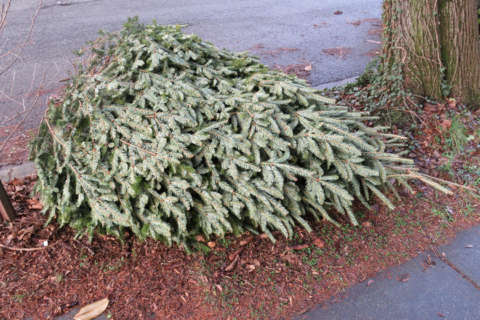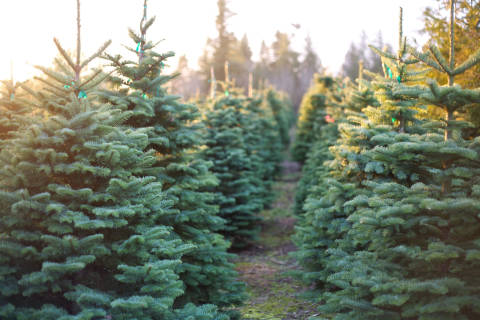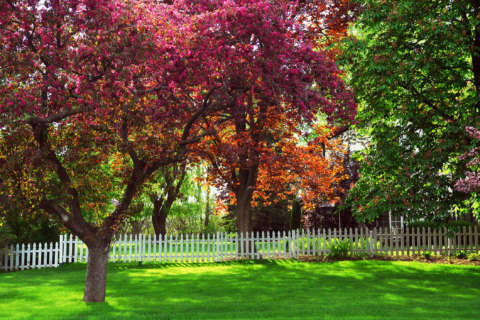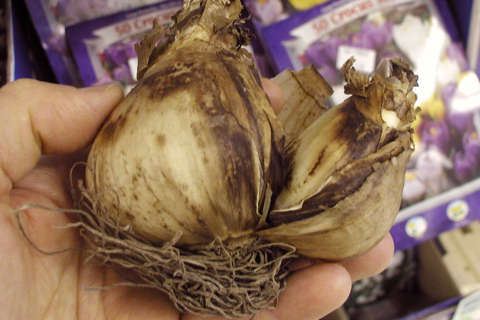WASHINGTON — WTOP Garden Editor Mike McGrath shares some tips for hauling out your old Christmas tree and how to recycle it in your garden. Plus, some helpful information if your cat likes to chew on houseplants.
Have an epiphany — and haul out that old tree
Are you having an epiphany? You should, as Saturday is traditionally celebrated as the Epiphany — the day the three kings arrived at the stable to pay tribute to the Baby Jesus. (They probably would have gotten there sooner if they had brought a queen along with them; no way are three men going to stop and ask for directions. And did one of them offer to change a diaper? We think not.)
Anyway, Jan. 6 is also the traditional date to take down all of your holiday decorations — but seeing as the weather is in the single digits, let’s say a Perfect Act of Contrition: leave the outside lights up and start taking down the tree instead.
Basting and tarping can prevent a wet mess
Begin by removing and packing up all of the ornaments; then the lights.
Now, you’ll need a turkey baster and a clean tarp or old sheet to finish the job.
Use the turkey baster to suck any leftover water out of the tree stand. Then put on protective gloves and gently lay the tree down sideways on the tarp.
Do not try and just carry the old tree outside on its own; even trees whose water needs have been exceptionally well met have a lot of needles ready to drop. Instead, place the undecorated tree sideways on a tarp or old bedsheet and carry it outside on that protective covering.
Make sure you have a helper to hold the doors open for you, and make sure you go through those doors butt-end first. (That’s the tree’s butt; not yours.) Otherwise, you’ll catch the skirt on the sides of the doorway and make a big mess.
Take the time to do it right and you won’t drop any of those hard-to-clean-up needles on the carpet.
Old tree = free mulch
OK — so you got the ornaments and lights off and didn’t make a mess because you carried your old cut Christmas tree outside on a tarp. Now what?
One excellent way to recycle a tree is to use a bow saw, loppers and/or hand pruners to remove all the branches and use them as a springy protective mulch.
Cut everything off close to the trunk so the pieces are big, then use these boughs to cover any overwintering pansies or spring bulb beds. Their natural springiness makes them great protection for the pansies. The sharpness of the needles will deter evil squirrels from digging up your tulips and prevent deer from easily getting at the emerging plants in the spring.
Or just spread the boughs around your azaleas and rhododendrons; they’re the perfect mulch for these shallow-rooted plants.
Now that’s what I call a bird feeder!
Here’s another recycling option for that cut Christmas tree: Carry it outside and stand it up in the backyard — preferably in a place where you can see it from your windows. Then hang lots of suet feeders on the top half of the tree.
Suet provides the high-energy food that over-wintering birds need — especially on these frigid days. The branches of the tree give the birds room to perch and easy access to that food. Those branches also provide excellent protection from predators. (Some of the birds may even build nests in the tree!)
Keep the feeders full of suet and enjoy the show over the winter — you’ll see dozens of birds every day. But stop filling the suet cages when things begin to green up in the spring. The birds will then naturally switch over to eating the bad bugs that will just then be coming out of their deep winter’s sleep — an excellent payback for your thoughtful protection.
Pineapple-loving cat
Irene in Frederick writes: “Can you tell me if the leaves of a pineapple plant are toxic to cats? I have two kitties that love to chew on the leaves.”
Ah yes, the fun houseplant: you save the top of a pineapple, position it in water or wet soil, and with any luck it’ll grow a cute little baby pineapple up top. Lots of fun.
Anyway, the leaves of a pineapple plant aren’t toxic, but they are sharp and tough enough to cause some mouth damage. And they could contain substances like silica that, although technically not poisonous, can be mildly irritating to the stomach.
So move that plant to a more difficult-to-reach location and replace it with a plate or planter of cat grass. Available at any pet store, these grasses are fast-growing, soft and juicy, and satisfy cats’ need to chew on plants every once in a while.








